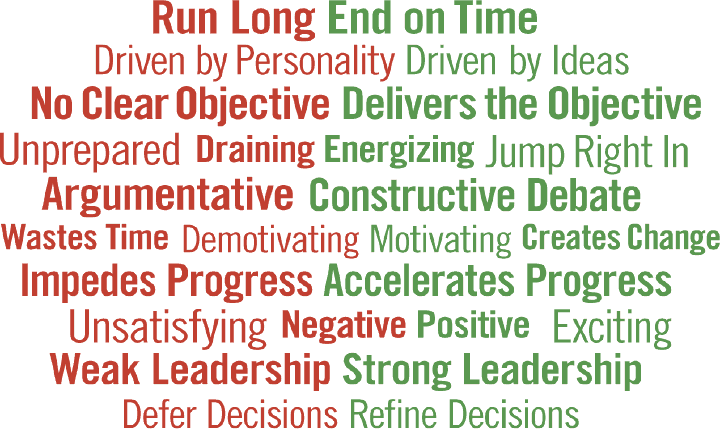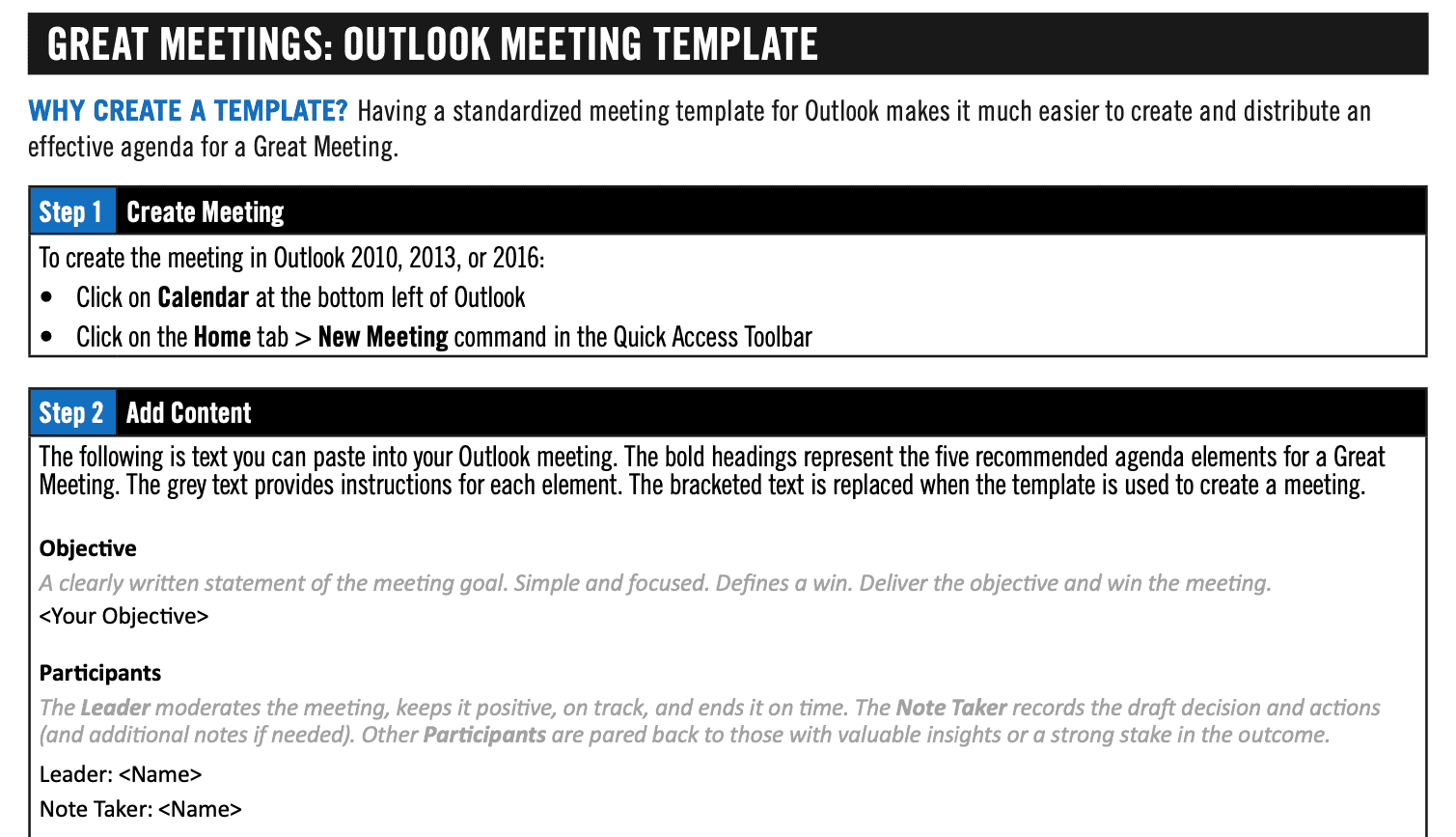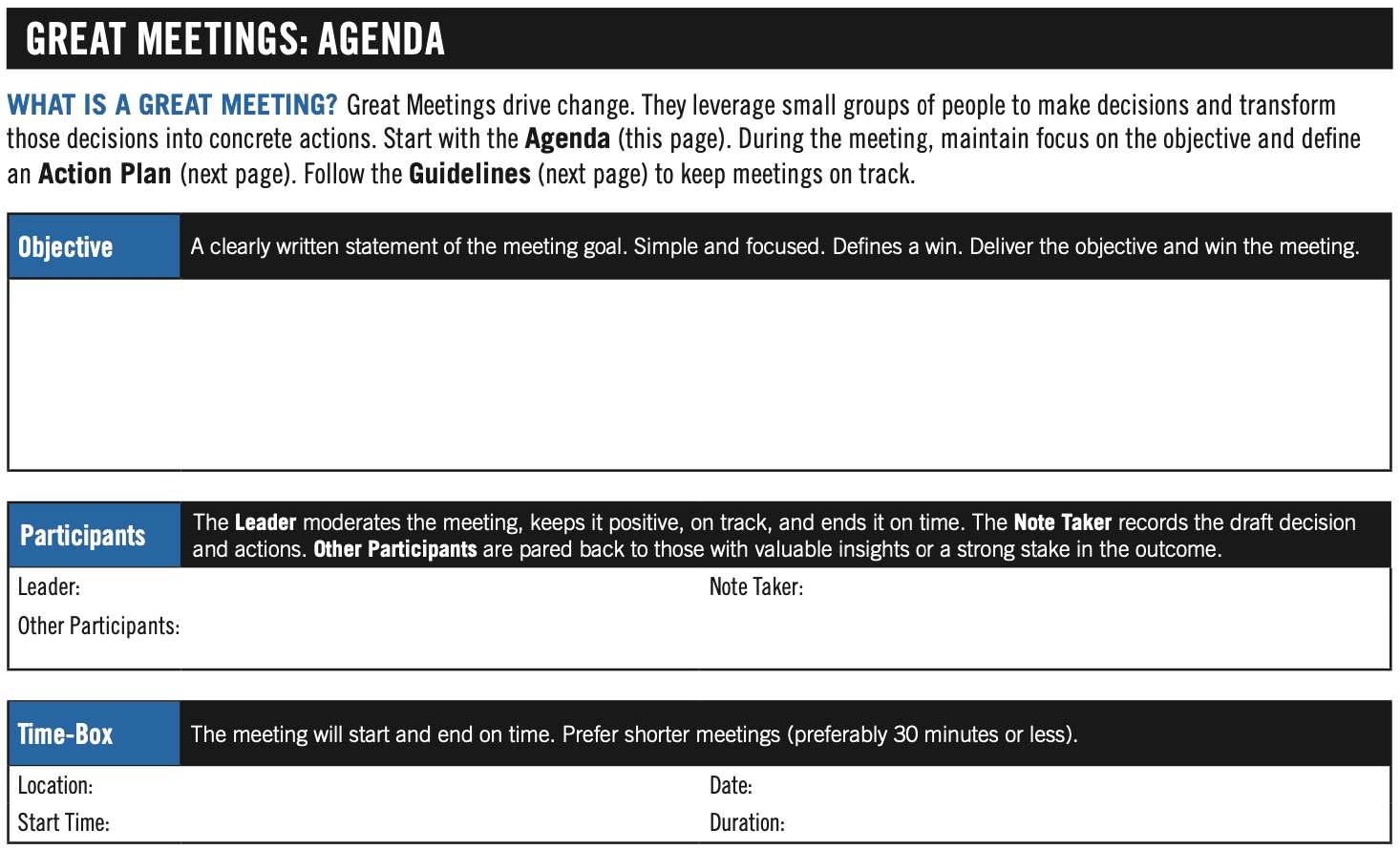How to Run Great Meetings

Why Have Great Meetings?
Most companies have too many meetings, with too many people, taking too much time, and delivering too little value. Meetings that waste time, drain energy, lead to conflict, and impede progress. However, Great Meetings eliminate this waste, motivate people, and accelerate progress.
What Are Great Meetings?
Great Meetings drive change. They leverage small groups of people to make decisions and transform those decisions into concrete actions. They stand in stark contrast to typical meetings, which are often talking shops ruled by personality with few substantive outcomes.

How to Have the Best Meetings
Before the Meeting
Create An Effective Agenda
There are five elements to an effective meeting agenda:
| Element | Description |
|---|---|
| Objective | A clearly written statement of the meeting goal. This is NOT a “topic” or “subject”. It is a specific desired outcome. A meeting’s success can be measured against its objective. For best results, keep the objective simple and focused. |
| Participants | Smaller meetings are better. Relentlessly pare back. Only include people with valuable insights or a strong stake in the outcome. |
| Time-Box | Participants appreciate a strictly enforced start time and end time. Nothing maintains focus like an enforced deadline. |
| Context | Why this meeting is important, what will be debated, and what people currently think. When appropriate includes a proposed decision (a starting point for discussion). |
| Preparation | Required preparation for the meeting. If a participant doesn’t have time to prepare, they shouldn’t have time to attend. |
Prepare Your Team
The leader and participants have a shared commitment. The leader commits to providing the smallest possible, most clearly written set of preparation materials that support the objective. The participants commit to carefully reviewing those materials before the meeting.
During the Meeting
Stay Focused
Great Meetings stay tightly focused on delivering the objective. Tangents and circular debates are quickly identified and stopped.
Move Fast
Great Meetings start on time, end on time, and move quickly. Start by framing the objective and set the tone by getting right down to business.
Be Positive
Great Meetings are positive and motivating. They are an arena of ideas. The focus is on the idea – not the person advocating the idea. People leave excited and committed.
Elicit Participation
Great Meetings are active. Everyone participates. Otherwise – why are they there? People are free to decline an invite if they will not add value. People are free to leave if they are not adding value.
Be Proactive
Great Meetings have a strong bias to action. Minutes (what happened) are deemphasized. Actions (what will happen) are emphasized. The meeting closes with a concise recap of the decision and actions.
After the Meeting
Distribute Action Plan
The leader distributes an Action Plan – a summary of the decision and supporting actions. Each action has an owner and a due date. The due date is proposed and “owned” by the action owner.
Confirm Completion
The leader owns the Action Plan and follows-up to ensure that all actions are delivered successfully and on time.


Benefits of Great Meetings
In the short term, Great Meetings result in fewer and better meetings.
In the long term, Great Meetings create an entirely new meeting culture – one focused on accelerating decisions and actions.
Team Member Roles
Great Meetings involves the following roles:
| Role | Description |
|---|---|
| Leader | Creates Agenda. Ensures preparation is easy. Ensures meetings are focused, fast, positive, participative, and proactive. Coaches participants. Follows-up on Action Plan. |
| Note Taker | Records decision and actions (i.e., the Action Plan draft). This is usually a different person than the Leader. |
| Participant | Comes prepared. Honors meeting guidelines. Delivers actions. |
Key Insights
Recognize Meeting Variants
Great Meetings leverage small groups of people to make decisions and accelerate progress. Learn to recognize other types of meetings.
| Variant | Description |
|---|---|
| Brainstorming | Great Meetings are about decisions. Making those decisions reduces the universe of options. Brainstorming is the opposite. The deliverable is an expanded universe of options. |
| Work Session | Work Sessions are about efficiently completing work with a small team. The deliverable is completed work (e.g., mapping a manufacturing process). |
| Training | Training is about efficiently conveying information and reliably building skills. The deliverable is transferred skills. |
| Infomercial | Many meetings are infomercials in disguise. There are far more efficient ways to disseminate information (e.g., a well-crafted email). Eliminate this type of meeting. |
Consider the Option of No Meeting
Most companies have far too many meetings. So think once, twice, and thrice before organizing a meeting. Ask yourself: “How do I resolve this without a meeting?” Consider a series of informal conversations or email exchanges as an alternative. Reserve meetings for situations where a decision needs to be rigorously tested.
Meetings Are the ‘D’ in IDA
IDA is an outstanding framework for transforming information into results.
- Information provides the foundation for making effective decisions.
- Decision is the process of making effective decisions.
- Action transforms those decisions into results.
Great Meetings deliver focus. They are the pivot between Information and Action. Information is discussed and a course of action is decided.
Win the Meeting
A well-crafted meeting objective captures the essence of a win. Deliver the objective and win the meeting. Use the goal of winning the meeting to motivate and energize participants.
Raise the Tangent Flag
Tangents kill momentum. Agree in advance that any participant can raise their hand to alert participants that the meeting is heading off on a tangent and should be refocused on the objective. We call it raising the “tangent flag” and it is an amazingly effective tool.
Better or Different
Before proposing a new approach during a meeting ask yourself – is the new approach genuinely better or is it simply different? Let go of ideas that are simply different and focus on ideas that add significant new value.
Prefer Short Meetings
Strive for meetings that are 30 minutes (or less). Keep on track by asking the note taker to announce when the time is halfway complete and nearly complete. You will be amazed at the energy and focus that can be sustained in short meetings.
The Arena of Ideas
Great Meetings are a venue for healthy debate that tests, refines, and firms decisions. It is important for that debate to focus on ideas, not on the people presenting those ideas. Carefully watch for instances where personalities are injected into the debate. Recognize instances of “I” and “You” that personalize the debate. Coach participants to say things like “That idea has a lot of merit” instead of “I like that idea”.
Seek Underlying Concerns
When participants raise an objection, it is often a symptom of a deeper concern. The only way to truly address the objection is to root out the deeper concern. A prime example is when someone objects to something, not because of what is on the table today, but because of something that happened in the past. Seek out and address the underlying concern to successfully move meetings forward.
Say No to No
Negativity can crush a meeting. Here are tips for managing negativity:
- Establish expectations upfront with simple ground rules for behavior.
- As a leader, always inject a strong dose of positive into meetings.
- Don’t meet negativity with negativity – it simply “escalates the bad”.
- Acknowledge concerns and reframe the conversation to the objective.
Level and Difficulty
The Level is Foundation. Great Meetings drive progress. They increase the pace and quality of decisions and actions. They are a catalyst for change.
The Difficulty is Moderate. Developing skilled meeting leaders takes time, as does establishing new habits and behaviors for participants.
Rate Your Meetings
Do you have Great Meetings? Answer ten simple questions to see how close you are to a model implementation.
| Question | ✔ |
|---|---|
| 1. Do meetings have a simple, focused and “winnable” objective? | |
| 2. Are meetings small – pared down to a minimum? | |
| 3. Is preparation easy and do people come prepared? | |
| 4. Are meetings short and do they end on time? | |
| 5. Are tangents quickly identified and stopped? | |
| 6. Is discussion ruled by and focused on ideas – not people? | |
| 7. Are meetings positive, energetic, and motivating? | |
| 8. Do all attendees actively participate? | |
| 9. Is a strong focus kept on delivering (winning) the objective? | |
| 10. Are decisions and actions published and followed to completion? |
Comments or Questions?
We welcome your comments and questions. Contact us at: info@vorne.com.


